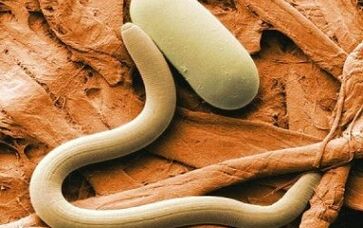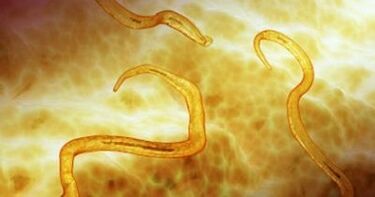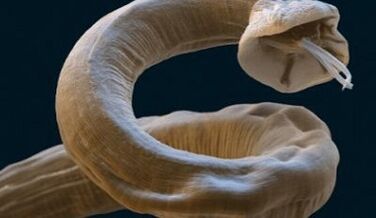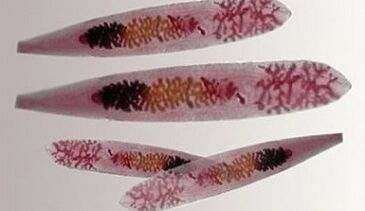Everyone probably knows what worms are and where they come from.But not everyone can answer what worms are, and most importantly, what harm they can do to the human body.
Characteristics and types of helminthiasis
Intestinal helminth infections are a group of human diseases caused by the ingestion of parasitic worms, namely worms that live in the internal organs of humans, affecting tissues and disrupting their normal functioning.
Parasites can settle in almost any organ: the intestines, lungs, gall bladder, liver and even the brain.The name, course, consequences and symptoms of helminthiasis depend on the type of parasite that causes the disease.
But there are some generalized types of helminthiasis:

- Contact.The infection occurs directly from an already infected person, through contact.The most common are hymenolepidosis caused by dwarf tapeworm and enterobiasis caused by fungal worms.The parasites crawl out of the rectum and lay eggs on the skin of the person.Further distribution is through food and household goods.The main cause of infection caused by contact helminthiasis is non-observance of personal hygiene rules, as well as improper processing of products and non-observance of storage rules.
- Geohelminthiasis.It is characteristic that there is no need for an intermediate host;parasitic worms spend their entire life cycle in a single organism.The eggs and larvae of the parasites can only live in the external environment, most often in the soil.Very rare species can grow indoors, most of them only in soil or water.Children who often play with the soil, as well as those who work on farms and pastures, are most susceptible to geohelminthiasis.Human infection occurs through consumption of unwashed vegetables and fruits and untreated drinking water.It is possible for the roundworm to enter by swallowing dust or through the skin.
- Biohelminthiasis.The development of helminths requires the participation of an intermediate host, most often an invertebrate.Basically, biohelminthiasis is transmitted through blood-sucking insects.These types of parasites live in the blood of the final host, enter the body of the insect through a bite, then develop inside it and reach another person through the same bite.But it is also possible to release eggs and larvae into the external environment, as in the case of geohelminthiasis.Each type of worm requires its own special type of intermediate host.

Symptoms and causes of helminthiasis
The clinical symptoms of helminthiasis depend directly on the type of parasites in the human body and their habitat.Depending on the affected organ, various manifestations of the disease occur, which often confuses the exact diagnosis.

Helminthiasis goes through acute and chronic stages of development.The acute stage lasts up to 8 weeks, but the chronic stage can last for years.The acute stage is characterized by similar symptoms for all types of helminthiasis, since an immediate reaction of the immune system occurs in the human body after the appearance of a foreign object.
In the chronic stage, the symptoms become more specific to each disease and cannot be generalized.Everything depends on the affected organ, for example, when the parasites are localized in the intestines, abdominal pain and stool problems are typical.
Symptoms of helminthiasis:
- Increased body temperature.
- Excessive sweating and swelling.
- Painful muscle and joint pain.
- Diarrhea or, conversely, frequent constipation.
- Dehydration, frequent vomiting.
- Enlarged liver, spleen, lymph nodes, bloating.
- Rashes on human skin.
- Increased level of leukocytes.
- Iron deficiency anemia.
- Itching of the skin and anus.
- Nervous system disorders, apathy, irritability, depression.
- The presence of bloody secretions in the stool or when urinating.
- Pancreatitis, jaundice, hepatitis, intestinal obstruction.

Certain types of helminthiasis are characterized by an asymptomatic, latent course of the disease.This is dangerous, because due to severe damage, a person's internal organs can simply burst, after which the whole body will inevitably become infected with parasites, and as a result, such serious consequences as anaphylactic shock or peritonitis can occur.
Special attention should be paid to the manifestations of helminthiasis in children, since they are at the greatest risk.
They are often mistaken for other diseases and enter a critical stage of damage to the body.Children's immunity is not yet fully developed and does not show obvious signs of damage.
The most common childhood disease is enterobiasis.In second place are various types of roundworms, which are most common in children's diseases.It is imperative to pay attention to the consistency and regularity of stool, the appearance of various skin rashes, and do not ignore complaints of itching in the anal area.
The main causes of helminthiasis:

- Eating unwashed vegetables, fruits and berries.It is very important to follow hygiene and sanitation regulations.Carefully process the purchased products;for children, it is advisable to use special products for washing fruits and vegetables.Hand washing is mandatory before every meal.
- Meat and fish products.In order to avoid infection and serious consequences, quality heat treatment is required, as well as certification of the purchased product.Verification of compliance with the storage conditions of the prepared semi-finished products.The consumption of fish products bought on the side of the road is unacceptable.
- Earth and sand.This mainly applies to children, as they tend to put everything in their mouths.Do not allow your child to eat sand in the sandbox or dirt in the summer house while playing.Anything dropped on the floor or open ground is out of the question.
Worm eggs surround us everywhere, so we should pay extra attention to personal hygiene in order to prevent possible helminthic diseases as much as possible.
Classification of parasites
Helminths are classified into three classes depending on their shape and appearance:
- Roundworms.To date, more than 80,000 worm species have been described from this class.They can cause serious damage to the human body and cause various helminthic diseases.The development of roundworms goes through 5 stages, of which four are larvae and one is an adult.With each transition, the environment or intermediate host changes.The most common representatives:

- roundworm - causes a disease called ascariasis.This type of parasite can only live and feed in the human body.Cylindrical worms are characterized by coughing, during which the larvae push into the human throat and return to the intestines as mature individuals;
- Pinworms cause enterobiasis in the human body and parasitize the intestines.Once inside the host, they are characterized by indigestion, itching near the anus, and in some cases inflammation of the genitals, especially in women.
- Tapeworms.More than 10 orders of tapeworms live in the human body.This is the most common class of parasites that cause extremely dangerous diseases.They go through two larval stages and reach their final host as adults.They enter the human body from an intermediate host, most often through the meat of an infected animal.Therefore, in order to prevent the disease, it is important to monitor the correct preparation and selection of meat products.The most common types of helminths belonging to this class are:
- tapeworm - causes the disease taeniasis, which is characterized by frequent vomiting, nausea or loss of appetite;
- cattle tapeworm is a less dangerous disease, but it is very difficult and requires long-term treatment;
- Echinococcus is a type of worm that can cause migraines, dizziness, and even epileptic seizures.
- Flatworms (fluff).What are intestinal worms?The development of this class requires the presence of an intermediate host.These parasitic worms are the causative agents of trematodes.The most dangerous species in the class:

- fluke opisthorchiasis - enters the human body with fish meat, most often carp, affecting the bile ducts of the liver;
- schistosomas - spread through water, causing schistosomiasis, which is a very serious disease with extremely serious consequences;
- Paragonim is a lung fluke, the causative agent of paragonimiasis, infection is possible only by eating crayfish, crayfish or pork.
Each of the listed human worms is only a small part of the diversity of parasites that exist today.According to some data, there are more than 1 million varieties.
Diagnosis and treatment of helminthiasis
Science does not stand still, and many methods have already been developed and are actively used to identify helminthic diseases.Modern methods make it possible to accurately determine the type of parasites in humans and the degree of tissue damage in their place.
Basic methods of diagnosing helminthiasis:
- Microhelminthoscope.It is used to detect eggs and larvae of worms.These include the methods of Kato, Kalantaryan and Fulleborn.Separately, these methods do not allow accurate identification of all types of parasites.But overall, they give good results, especially regarding the intensity of the spread of parasites living in the body.
- Macrohelminthoscope.Most effective in identifying worms and roundworms.Using a Petri dish and a magnifying glass, they help detect parasites in the feces.
- Biopsy.If there is a possibility of helminth parasitism in human muscle tissue, a sample is taken and sent for research.This method allows for the most accurate diagnosis.
- Immunological.They are performed by testing the patient's blood to detect antibodies against certain types of helminths that live in the human body.
- Analysis of bile or duodenal contents.It is used in case of damage to the liver, gallbladder and duodenum.
- Instrumental.These include ultrasounds, X-rays and computer tests.It is used to determine the extent of damage caused by worms to the human body.And also for checking other internal organs.
Medical methods are used to treat the identified diseases.However, it was found that complex therapy with several drugs is more effective than monotherapy based on a single anthelmintic.
Helminth infections are most often treated by prescribing a single dose of tablets with an active ingredient such as levamisole.The dose is selected according to the age of the patient.This helps to weaken the parasites.
Then, after 3 days, medicine containing mebendazole or albendazole should be taken.This integrated approach significantly speeds up and increases the effectiveness of treatment.
It often happens that a person does not even know about the worms in his body.In this context, it is recommended to take preventive courses of anthelmintic drugs.This is especially true for preschool children and pet owners.
Parasites in humans can cause serious damage to internal organs.Timely diagnosis and treatment help to stop the development of these diseases in time and prevent serious consequences.






































